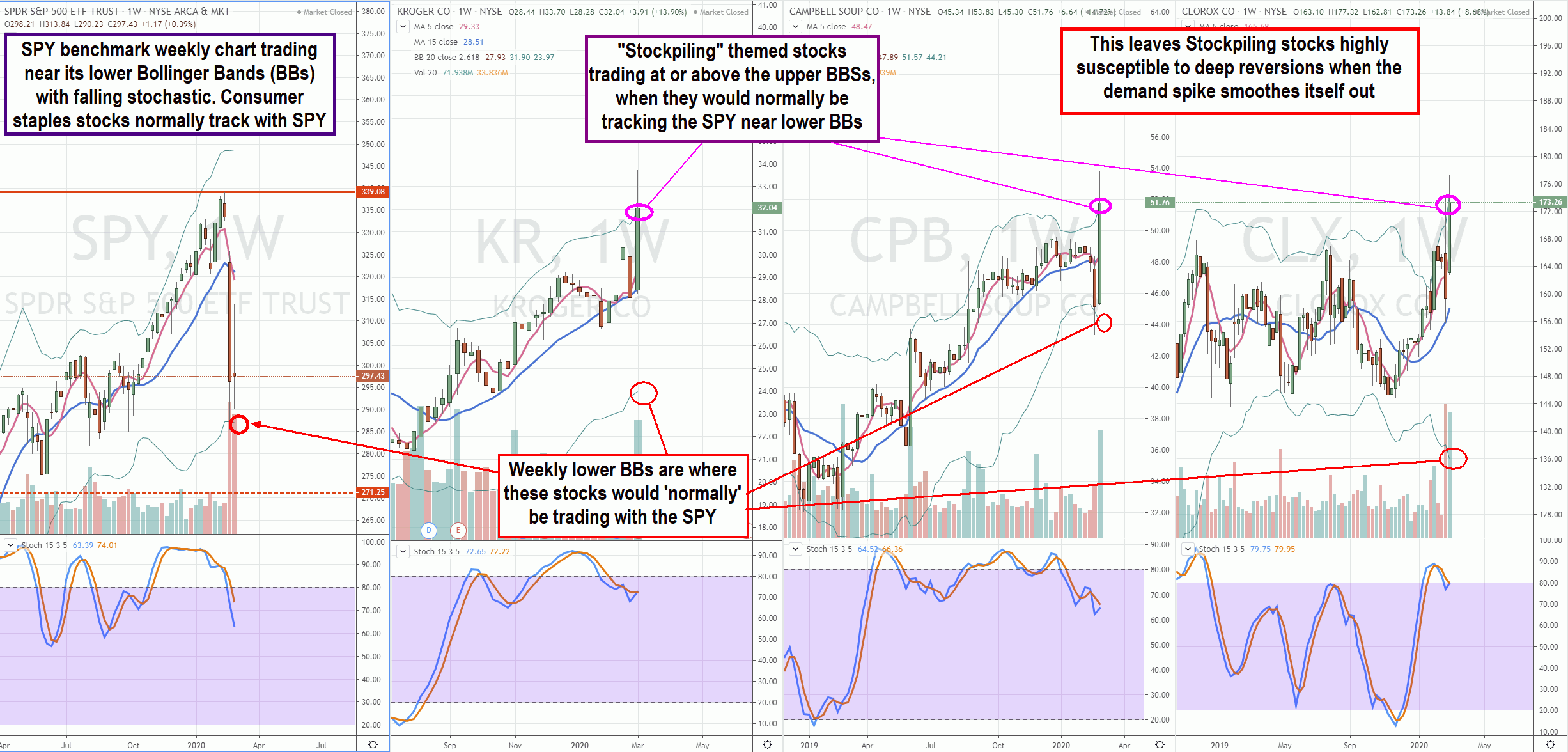As the stock market slides from coronavirus fears, anxious consumers are actively emptying out store shelves of necessities including cleaning products, first aid kits, sanitizers, non-perishables and oat milk (up 313-percent in sales according to Nielson). This “stockpiling” phenomenon has fueled spikes in shares of producers, suppliers and retail outlets seen as benefiting from this trend. While the stockpiling theme is real, investors will find it prudent to avoid the temptation to chase ‘stockpiling’ themed stocks. We will illustrate just how overbought the prices have moved on the stockpiling narrative.
Stockpiling is Real
The demand spike generated from the stockpiling effect has been reported by manufacturers and echoed by retail outlets. Costco (NASDAQ: COST) attributed a 3-percent total and comparable revenue boost to coronavirus concerns (stockpiling) in their recent Q2 fiscal 2020 earnings report. This doesn’t reflect Feb. 2020 where the stockpiling effect became more noticeable as COVID-19 spread into the United States. Campbells Soup (NYSE: CPB) raised full-year 2020 adjusted EPS forecasts on March 4, 2020. The company attributed stockpiling for the major spike in product demand for their non-perishable food items including SpaghettiOs and Swanson canned chicken sending shares soaring to three-year highs.
Engineering Accrual-Based Accounting
Publicly listed companies must abide by accrual-based accounting, which means revenues are posted at the time of billing or invoicing of the products or services. The intent is to provide investors with the most up to date transparency on sales data. However, accrual-based accounting can also be engineered to imply artificial revenue growth by pre-shipping multiple orders to customers ahead of time, or bulking shipping with a discount. In extreme cases, shipping orders in bulk that weren’t ordered anticipating returns at a later date, but the revenue would be booked for the current quarter. Channel stuffing intends to artificially boost the perception of demand to bump up revenues to meet or exceed forecasts.

Reversion Similar to Channel Stuffing
While stockpiling is not channel stuffing since it’s driven by real demand. The reversion back to the mean is inevitable as consumers resume normal spending habits or spread out their shopping after consuming their stockpiles. The revenues are front-loaded but smooth out over time as reversion kicks in. This point was echoed by Campbell’s CEO Mark Clouse, pointing out the lack of visibility in sustaining the elevated level of demand and whether sales were just pulled forward from a later month. This was the justification for Credit Suisse to downgrade Kroger (NYSE: KR) after share ran up on stockpiling data.
Stockpiling Doesn’t Mean Consumption
Consumers stockpiling items isn’t a sign of increased consumption which requires replenishment, rather they are purchasing items not meant to be immediately consumed. Items are meant to be stored away to be consumed in the future. The essence of stockpiling is to ensure items are available at home in case supplies run out or as needed. The very nature of stockpiling is a temporary bump in supplies. It’s meant to accelerate the purchasing of items that either wouldn’t have been purchased or purchased in a longer time frame.
Supply Chain Disruption Versus Stockpiling Demand
Costco pointed out the difficulty in keeping stores stocked due to global supply chain disruption. Campbell’s CEO Clouse also noted that the global supply chain disruption is causing the company to search for alternative ingredients suppliers to keep up with the demand. Roughly 12-percent of product ingredients are sourced internationally of which two percent come from China.
How to Know if Your Chasing
While it is tempting to buy into the stockpiling narrative, it’s prudent to bide your time and avoid chasing overbought entries. Consumer staples stocks are not meant to be momentum stocks and usually track the S&P 500 (NYSEARCA: SPY) benchmark index ETF. By comparing the wider time frames, it becomes visually apparent how overbought the stockpiling shares are trading when prices exceed the upper Bollinger Bands (BBs) while the SPY is trading closer its lower BBs. The upper BBs represent the nominal best-case scenario where stocks should be trading parallel to the SPY trading at upper BBs. Shares of Clorox (NYSE: CLX) are trading near the weekly upper BBs at $174.34, when the 5-period moving average (MA) is at $157.75 and the lower BBs are at $136.09. Investors looking for entries should at least wait for pullbacks to the 5-period MA price levels on the reversions if not the 15-period MAs to avoid overpaying for what may turn out to be a temporary price spike.
Before you make your next trade, you'll want to hear this.
MarketBeat keeps track of Wall Street's top-rated and best performing research analysts and the stocks they recommend to their clients on a daily basis.
Our team has identified the five stocks that top analysts are quietly whispering to their clients to buy now before the broader market catches on... and none of the big name stocks were on the list.
They believe these five stocks are the five best companies for investors to buy now...
See The Five Stocks Here
Wondering when you'll finally be able to invest in SpaceX, Starlink, or X.AI? Enter your email address to learn when Elon Musk will let these companies finally IPO.
Get This Free Report
Like this article? Share it with a colleague.
Link copied to clipboard.